Introduction: Compression Socks Aren’t One-Size-Fits-All
Compression socks are not all the same—even though they might look similar at first glance. For brands, retailers, and buyers in the health and wellness sector, knowing the difference between medical compression socks and everyday compression socks isn’t just helpful. It’s necessary.
Why? Because choosing the wrong type can affect your customers’ health, comfort, and satisfaction. Worse, it can lead to complaints, returns, and reputational damage.
In this article, we’ll break down the key differences between these two categories. We’ll cover everything from pressure levels and medical regulation to material construction and common use-cases. If you’re sourcing or customizing compression socks for your line, this guide will help you make informed decisions and match the right product to the right user.
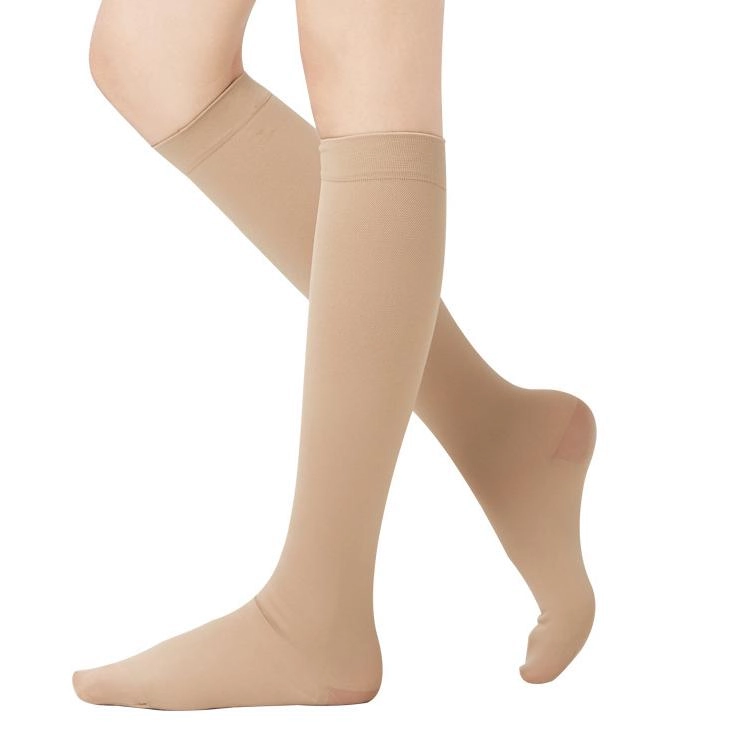
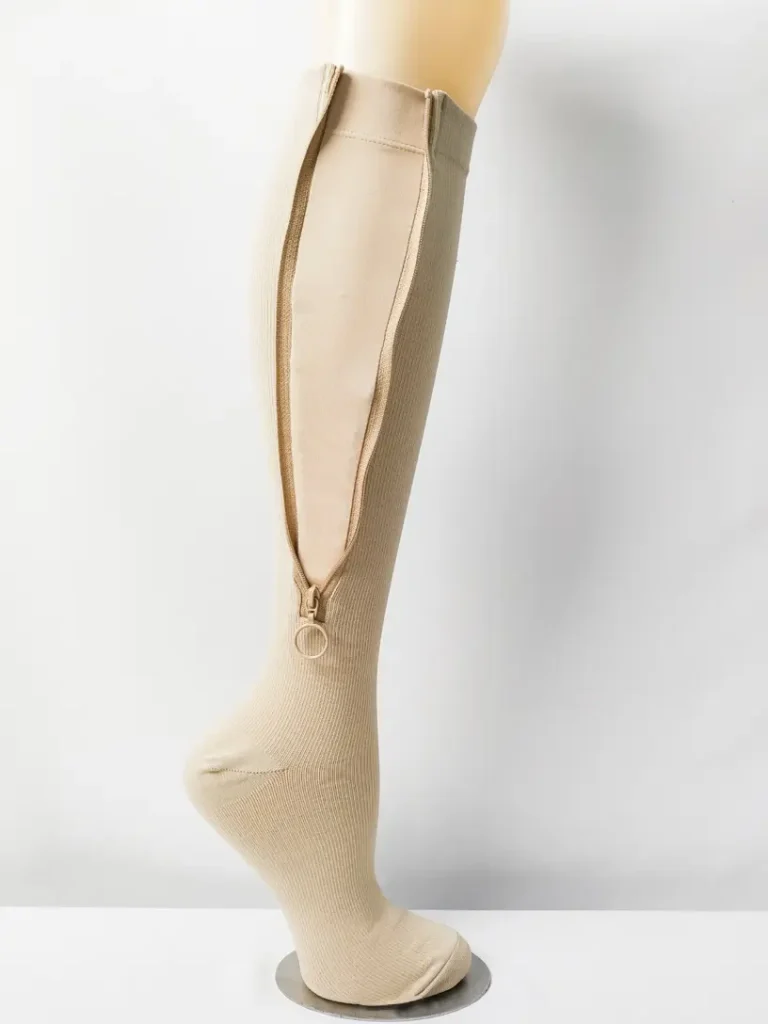
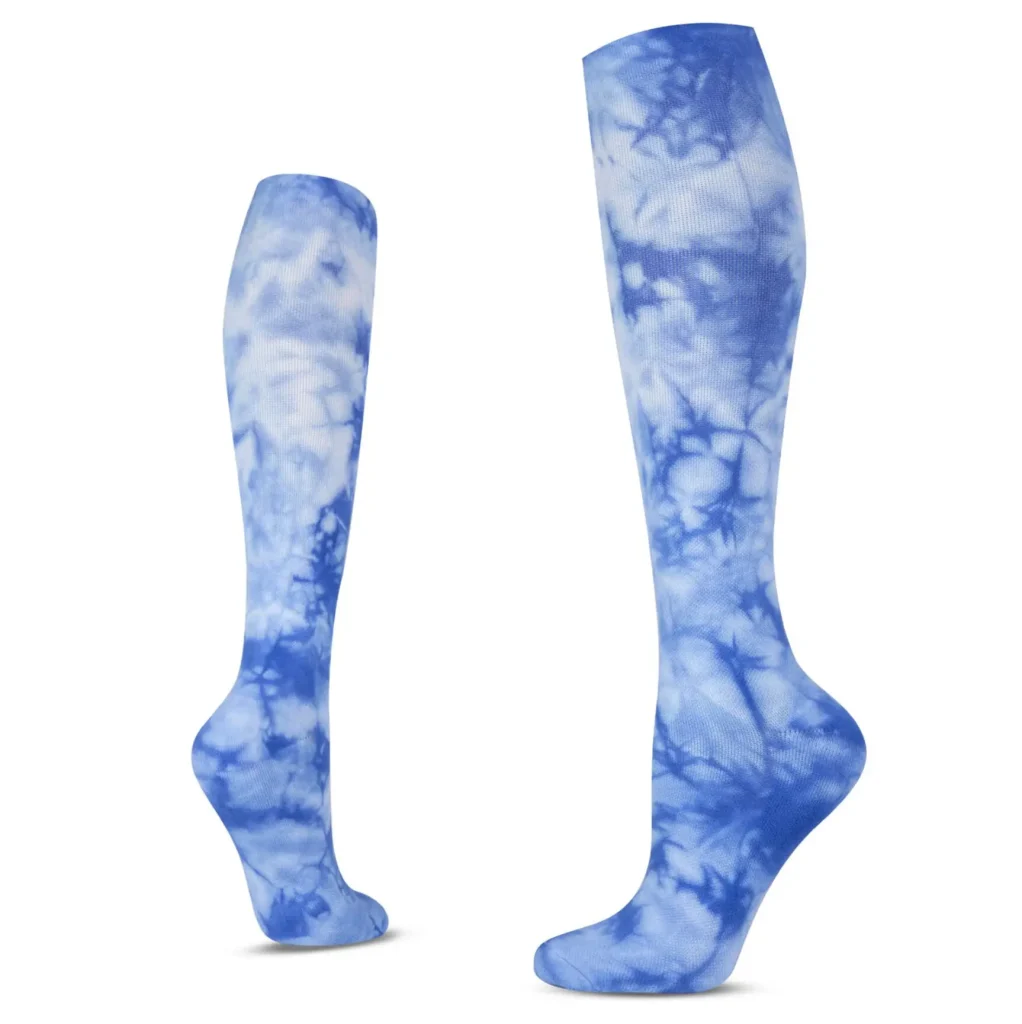
What Are Medical Compression Socks?
Medical compression socks are classified as medical devices. They’re engineered specifically for therapeutic purposes, often under physician direction.
The defining feature? Graduated pressure that ranges between 20–40 mmHg, depending on the condition being treated. These socks are designed to apply the strongest compression at the ankle, gradually decreasing toward the calf and sometimes the thigh.
Typical medical uses include:
- Chronic venous insufficiency
- Deep vein thrombosis (DVT) prevention
- Post-surgical swelling and blood clot risk
- Lymphedema management
- Leg ulcers or venous eczema
Because of their medical role, these socks must meet certain regulatory requirements in many countries. For instance, they might need CE marking in the EU, FDA listing in the US, or certifications like RAL-GZ 387 in Germany.
These are not fashion items. They’re clinical tools—just as important as a walking cane or orthopedic shoe.
What Are Common Compression Socks?
Common, non-medical compression socks are not designed to treat health conditions. Instead, they serve general wellness purposes like:
- Reducing fatigue after standing or walking
- Enhancing athletic recovery
- Supporting leg circulation during travel
- Preventing mild swelling in feet and ankles
These socks usually apply a pressure of 8–15 mmHg, considered “mild” compression. While they might offer graduated compression, they’re typically not regulated as medical devices.
They’re widely available in retail and online stores. Styles include everything from solid-colored business socks to performance sports socks, maternity designs, and travel-friendly options.
Compared to medical compression socks, common variants are:
- Easier to wear
- More stylish and varied
- Less expensive
- Less clinically effective
For wellness and prevention, they’re often enough. But for actual treatment, they fall short.
Pressure Levels & Regulatory Standards
This is where things get technical—and crucial for buyers.
Compression pressure is measured in mmHg (millimeters of mercury). The higher the number, the greater the compression. Here’s a basic breakdown:
| Pressure Level (mmHg) | Type | Common Use-Cases |
|---|---|---|
| 8–15 mmHg | Mild (non-medical) | Travel, standing jobs, light swelling |
| 15–20 mmHg | Moderate (non-medical) | Mild varicose veins, fatigue |
| 20–30 mmHg | Class I (medical) | Varicose veins, mild edema, post-surgery |
| 30–40 mmHg | Class II (medical) | Lymphedema, chronic venous disorders |
| 40–50 mmHg+ | Class III/IV (prescription) | Severe circulatory issues, ulcers |
Regulations Vary by Region:
- USA: FDA registration may be required for Class I and higher.
- EU: CE marking and MDR (Medical Device Regulation) compliance needed.
- Germany: RAL-GZ 387 certification for medical quality standards.
- Asia-Pacific: Varies by country—Japan, for instance, has strict PMDA reviews.
Everyday compression socks don’t need to pass these hurdles. They’re generally classified as consumer health or athletic wear, not clinical devices.
This impacts not just labeling and marketing claims, but also the import/export paperwork, insurance eligibility, and retail compliance—especially in pharmacies or hospital stores.
Material Construction: Built for Purpose
Medical compression socks and everyday versions may look similar on the surface, but what lies beneath the yarn makes a big difference.
Medical Compression Socks Use:
- Higher-grade elastic fibers (e.g., Lycra®, Spandex) with controlled tension
- Multi-layer knitting technology to deliver precise graduated pressure
- Tight tolerances in manufacturing for consistent therapeutic compression
- Breathable yarns to prevent moisture build-up and skin irritation
- Flat seams or seamless construction to reduce pressure points
They’re made with clinical accuracy, often undergoing lab testing for pressure accuracy and durability. For patients with poor circulation or skin sensitivity, these technical features matter.
Everyday Compression Socks Use:
- Comfortable blends like cotton/nylon/spandex
- Fewer layers, less structured compression zones
- More variety in colors, textures, and fashion designs
- Cost-effective fibers and looser tolerances
They prioritize style and comfort over clinical precision.
For example, a travel sock might feel snug, but the pressure can vary throughout the sock due to simpler construction. That’s fine for airline passengers—but not for a post-surgical patient.
Who Needs Medical Compression Socks?
If you’re a brand targeting medical facilities, pharmacies, or orthotic retailers, your end-users likely include:
- Post-surgery patients (especially orthopedic or vein-related)
- Elderly patients with venous insufficiency
- Patients managing lymphedema
- Pregnant women with doctor-prescribed support needs
- Bedridden or low-mobility patients at risk of thrombosis
Medical socks are often prescribed or recommended by healthcare professionals. Your packaging and marketing must be compliant with medical advertising laws in your target countries. For B2B clients, it’s also crucial that you:
- Provide certificates of pressure testing
- Include detailed sizing charts
- Offer compression class labeling (e.g., Class I, II)
Who Benefits from Everyday Compression Socks?
Everyday compression socks are marketed more broadly—meaning wider audience, more use-cases, and more flexibility in design.
Target customer groups might include:
- Office workers on their feet all day
- Flight attendants, frequent travelers
- Athletes in training or recovery
- Pregnant women with minor swelling
- People with tired or achy legs
This market thrives on style, comfort, and wellness messaging. The socks may come in trendy colors, include features like arch support or mesh panels, and be available in ankle, crew, or knee-high lengths.
For brands and distributors, this category offers:
- Easier marketing claims
- Fewer regulatory barriers
- Higher sales volume potential
- More seasonal and lifestyle-oriented collections
Fit, Comfort, and Ease of Wear
Another key difference: how the socks feel when worn—and how easy they are to put on.
Medical Compression Socks:
- Much harder to pull on, especially for elderly users
- May require donning gloves or aids
- Fit must be precise (often with ankle and calf circumference measured)
- Can feel tight or restrictive, especially if not fitted properly
This is why customer education and sizing guides are so important in the medical category. A poor fit can reduce effectiveness or cause discomfort.
Everyday Compression Socks:
- Easier to wear, stretch more easily
- Available in broader size ranges (S/M/L instead of medical gradings)
- Less risk of discomfort or circulation issues
- Higher user satisfaction if marketed properly
Buyers looking for hassle-free wellness products will appreciate this ease of use.
Pricing, Margins, and Market Positioning
From a business perspective, medical compression socks and common compression socks live in two completely different price zones.
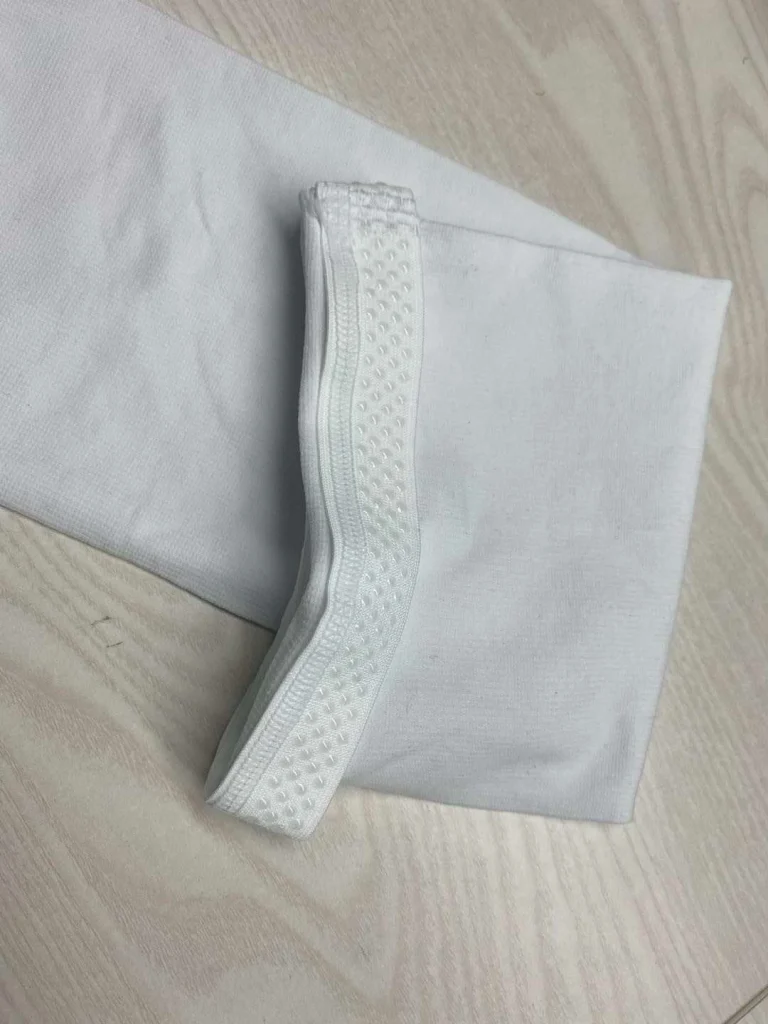
Medical Compression Socks:
- Higher production cost due to precision knitting and certification
- Lower volume per SKU
- Higher per-unit price (often $20–$60 wholesale)
- Longer sales cycles due to B2B medical partnerships
- More stable demand (driven by medical necessity)
Common Compression Socks:
- Lower cost, simpler production
- Fashion-forward or sport-focused variants
- Retail prices typically range from $8–$25
- High-volume sales in online marketplaces
- More promotional flexibility (bundles, influencer collabs, etc.)
If you’re building a retail brand, everyday compression socks offer scale. If you’re focusing on hospital channels or rehabilitation clinics, medical compression socks provide consistent, long-term demand—though with tighter regulatory oversight.
Performance and Efficacy Comparison
Understanding how medical compression socks perform versus everyday compression socks is key for positioning and advising customers. This section examines clinical outcomes, user feedback, and real-world performance differences.
Clinical Benefits of Medical Compression Socks
- Therapeutic Pressure Accuracy: Medical-grade socks (20–30 mmHg or higher) deliver validated graduated compression, proven in studies to reduce edema, improve venous return, and support post-thrombotic syndrome management. Precise pressure profiles (e.g., ankle-to-calf gradient) are tested via calibrated equipment, ensuring consistency across production batches.
- Evidence-Based Outcomes: Peer-reviewed research shows medical compression reduces leg swelling, accelerates healing of venous ulcers, and lowers DVT recurrence risk in high-risk patients. Healthcare providers often rely on specific compression classes (e.g., Class I or II) aligned with clinical protocols.
- Long-Term Compliance Considerations: Though tighter and harder to don, medical socks’ predictable efficacy encourages patient adherence when properly fitted and educated. Consistent use in chronic venous insufficiency or lymphedema correlates with improved long-term outcomes and fewer complications.
Practical Benefits of Everyday Compression Socks
- Mild Circulation Support: Everyday compression socks (8–15 mmHg or moderate 15–20 mmHg) help reduce leg fatigue, mild swelling, and exercise soreness by improving venous return moderately. Athletes and frequent travelers report subjective comfort gains and reduced “heavy legs.”
- Enhanced Recovery and Wellness: Sports studies often show improved perceived recovery when wearing mild compression post-exercise, though objective measures (e.g., lactate clearance) vary. For general wellness, everyday compression socks serve as a preventive accessory rather than a treatment.
- Ease of Use and Wearability: Since fit and donning ease are prioritized over strict pressure accuracy, users wear them consistently for travel, standing jobs, or casual exercise. Consistent daily use supports general leg health in non-clinical contexts.
Side-by-Side Comparison Table
| Aspect | Medical Compression Socks | Everyday Compression Socks |
|---|---|---|
| Compression Level | 20–40+ mmHg (Class I–III/IV) | 8–20 mmHg (Mild to Moderate) |
| Regulatory Classification | Medical device (FDA, CE, RAL, etc.) | Consumer wellness/product apparel |
| Proven Clinical Outcomes | Edema reduction, ulcer/heal support | Fatigue relief, mild swelling |
| Fit & Donning Difficulty | Precise sizing needed; may need aids | Easier S/M/L sizing; quick wear |
| Wear Duration & Compliance | Worn per medical guidance (daytime) | Worn daily for comfort or activity |
| Price & ROI | Higher unit cost; insurance possible | Lower cost; impulse or mass market |
| Target Audience | Patients with venous/lymph conditions | Travelers, athletes, office workers |
Key Selling Points by Customer Type
Tailoring your marketing and product offerings requires understanding different buyer personas and their priorities. Below are principal angles for each major customer type in compression sock wholesale or private-label programs.
Medical and Healthcare Channels
- Emphasize Clinical Validation: Highlight pressure classes, certifications (ISO 13485, FDA listing, CE marking, RAL-GZ 387), and third-party testing data. Provide pressure test reports and batch traceability to assure hospitals, clinics, and medical supply distributors.
- Detailed Sizing Support: Offer measurement guides, fit kits, or virtual fitting services. Educate B2B buyers (e.g., pharmacy chains) on how to guide end-users through proper sizing to ensure therapeutic efficacy and reduce returns.
- Regulatory & Reimbursement Guidance: Help partners navigate insurance coverage, prescription requirements, and local regulations. Position medical compression socks as reimbursable items where applicable, improving uptake by patients and institutions.
Athletic and Sports Retailers
- Performance and Recovery Focus: Position moderate compression (15–20 mmHg) for athletes seeking improved recovery, reduced muscle soreness, and mild circulatory support. Use testimonials or small-scale studies on perceived benefits during training and post-workout.
- Design & Aesthetics: Provide fashionable color options, team-logo customization, and varied lengths (ankle, calf, knee-high). For private-label sports lines, emphasize moisture-wicking, breathability, and seamless construction for blister prevention.
- Seasonal Bundles & Promotions: Offer product bundles (e.g., compression socks + performance underwear) or seasonal designs (e.g., tournament-themed). Leverage influencer or athlete endorsements to build credibility in sports communities.
Travel and Corporate Wellness
- Highlight Comfort and Convenience: Market mild compression socks (8–15 mmHg) for frequent flyers or office workers who stand long hours. Emphasize lightweight materials, easy donning, and discreet appearance under business attire.
- Wellness Program Partnerships: Collaborate with corporate wellness programs or travel accessory retailers. Provide educational content on preventing deep vein thrombosis (DVT) during long flights, supporting brand authority.
- Subscription or Replenishment Models: Introduce subscription-based orders for frequent users, ensuring replacement before wear degrades compression. This model helps ensure consistent sales and customer loyalty.
Retailers and E-commerce Platforms
- Broad Assortment Strategy: Carry both mild everyday compression and medical-grade lines to serve diverse consumer needs. Use clear labeling (“therapeutic grade” vs. “everyday comfort”) so shoppers choose appropriately.
- Educational Marketing: Develop guides, blog posts, and quizzes (“Which compression sock fits your lifestyle?”) to help consumers self-select. SEO-optimized content attracts organic traffic searching “medical compression vs. everyday compression.”
- Private Label and Customization: Offer customization services (logo, packaging) for boutique retailers. Small-batch production capability lets niche brands test new styles or target sub-segments (e.g., maternity compression socks).
How to Choose the Right Type for Your Product Line
Selecting which compression sock categories to include depends on your brand positioning, distribution channels, and customer insights. Below are steps to guide strategic product selection and sourcing.
Assess Your Target Market Needs
- Collect Customer Data: Survey end-users (e.g., patients, athletes, frequent travelers) about their key concerns: pain relief? swelling? recovery? comfort? Use analytics (website searches, bestseller insights) to gauge demand for medical vs. everyday compression.
- Segment Priorities: Determine which segments align with your strengths. If your distribution is primarily in pharmacies or clinics, focus on medical-grade lines. If you serve fitness retailers, prioritize performance/wellness compression socks with attractive designs.
Evaluate Supplier Capabilities
- Manufacturing Precision: For medical compression socks, confirm suppliers have pressure-testing equipment, quality assurance systems, and relevant certifications (ISO 13485, FDA, CE). For everyday lines, ensure flexible design options, cost-effective production, and faster turnaround.
- Minimum Order Quantities & Lead Times: Balance MOQ with expected sales volume. Small brands may start with everyday compression lines (lower MOQ, simpler compliance). Medical lines might require larger initial orders but often yield higher margins per unit.
- Customization & Branding Services: Check if the supplier offers private-label services (custom logos, packaging). For everyday compression, aesthetic variety matters. For medical-grade, clear clinical labeling and instructional inserts are critical.
Develop Product Roadmap and Pricing Strategy
- Tiered Product Portfolio: Consider launching a tiered range: entry-level mild compression socks, mid-range moderate compression for wellness/athletic use, and high-end medical compression socks for prescription channels. This captures multiple price points and customer segments.
- Margin and ROI Analysis: Calculate production costs (materials, testing, certification) versus wholesale and retail pricing. Medical-grade socks cost more to produce but can command higher margins and reimbursement opportunities. Everyday socks sell faster in volume but at lower per-unit margins.
- Marketing and Education Plan: Prepare clear product descriptions highlighting compression levels, benefits, and intended use. Develop educational resources (blogs, videos) comparing medical vs. everyday compression, guiding customers to the correct choice.
Pilot and Iterate
- Sample Testing and Feedback: Order samples of different compression levels and test internally or with focus groups. Collect feedback on comfort, fit, and perceived benefits.
- Soft Launch & Monitor: Introduce limited collections, track sales, returns, and customer reviews. Analyze which styles or compression levels resonate best.
- Scale or Adjust: Based on performance data, scale up successful lines, refine or discontinue underperforming SKUs, and plan next iterations (e.g., new colors, improved materials, updated sizing guides).
Conclusion: Matching Compression Solutions to Real Needs
Medical compression socks and everyday compression socks each serve distinct user needs—therapeutic treatment versus general wellness and performance. Understanding their differences in compression level, regulatory status, material construction, clinical efficacy, wearability, and cost is vital for any brand, retailer, or distributor in the compression sock market.
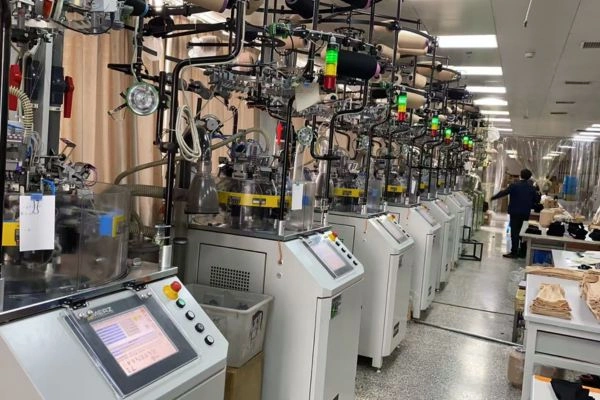
- Medical compression socks deliver precise, evidence-based therapeutic benefits under professional guidance but require tight quality controls, certified suppliers, and user education for proper fit.
- Everyday compression socks offer milder circulatory support for travelers, athletes, and office workers, with broader design freedom, simpler compliance, and faster market entry.
By assessing your target segments, evaluating supplier capabilities (pressure testing, certifications, customization services), and piloting product lines strategically, you can build a portfolio that addresses varied consumer needs while optimizing margins and brand reputation.
Ready to expand or refine your compression sock offerings? Explore customized manufacturing and private-label solutions designed for both medical-grade and everyday compression categories. Partner with experienced compression sock producers who combine rigorous quality assurance with flexible design services to bring reliable, high-performance compression socks to your customers. Your next step: align your product line with genuine user needs and stand out in a growing market.
FAQ
Q1: What’s the main difference between medical and common compression socks?
Medical compression socks are pressure-certified and designed for clinical use, while common compression socks offer general support for daily comfort.
Q2: Do medical compression socks require a prescription?
In some countries, higher compression levels (20–30 mmHg or more) require medical advice or a prescription.
Q3: Can brands private-label medical compression socks?
Yes, but your manufacturer must be compliant with international medical standards and provide testing documentation.
Q4: Are common compression socks effective for swelling?
Yes, for minor swelling and fatigue. They are not a substitute for clinical treatment.
Q5: How do I know which compression level to offer?
Start with moderate levels (15–20 mmHg) for general-purpose socks. For medical socks, follow standard classes (Class I, II, etc.).
